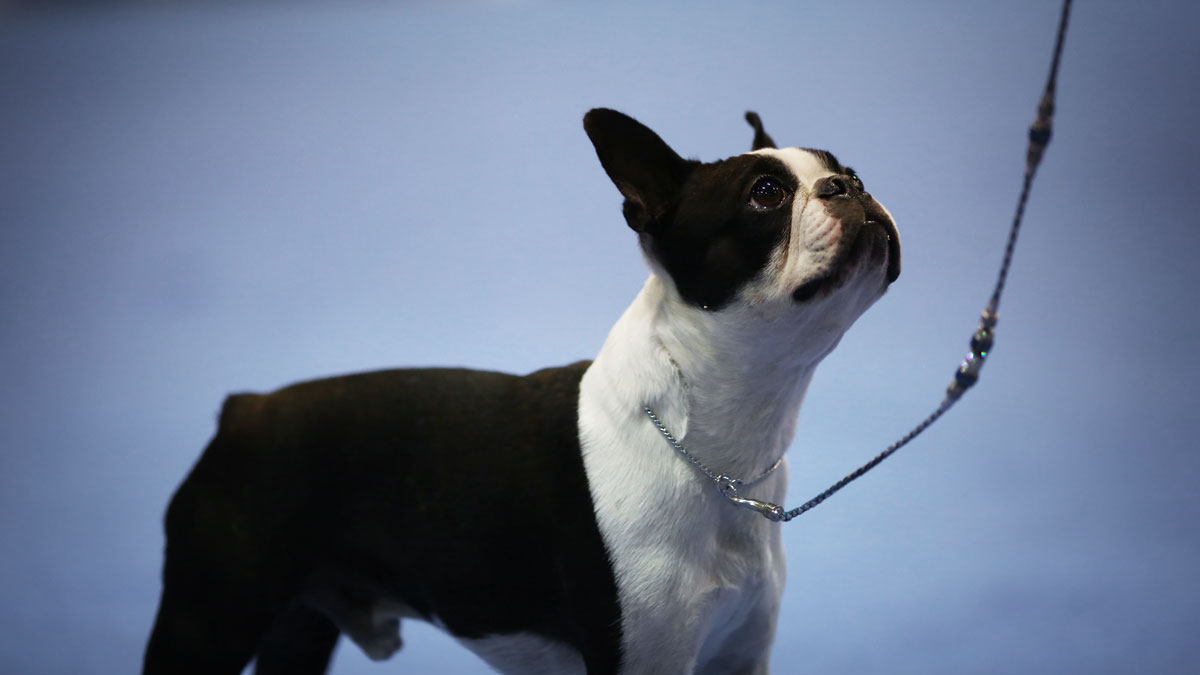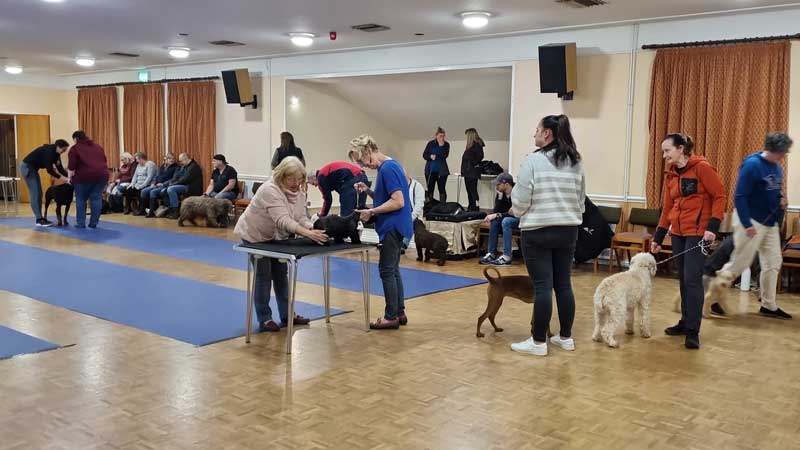Want to have a go?
Showing your dog
Many people love simply having their dog as a companion, but some of you might like to engage in other activities with them like Obedience, Agility or Showing.
This Club welcomes all owners and Boston enthusiasts but is licensed for and has experience in Showing them. It does have some members who are working on Obedience and Agility and is happy to try and connect people with similar interests, but this article is meant to help those you who want to know more about dog showing.


History of Shows
The motivations for showing dogs has evolved over time. Traditionally it was when villages held gatherings to sell, barter and exchange food and livestock. These gatherings became social events and soon, rather than only sell livestock they would bring along their best stock to compete against another landowner. At this time the value of a dog was judged mainly on its ability to work. A dog's purpose was varied and ranged from guarding to herding to vermin killing and some dogs were also used for the sport of fighting; either themselves or various other opponents. This social pastime was fuelled by the human enjoyment of competition and betting. The ability to drove, guard and fight was part of everyday life and monies won and lost on competitions in these fields drove the value of a dog and an interest in breeding the best one…for a particular purpose. Over time, certain types of dogs were found to be better than others for each kind of task and were bred to reproduce the same or similar type of dog. These are the different breeds we have today, but as their original purpose diminishes, their appearance has evolved – some more so than others - but all pedigree dogs can be traced back to their original purpose and this helps explain why each type of dog has a Kennel Club Breed Standard, which described what an ideal specimen for that breed should look like and against which there are judged at Shows.
Nowadays the motivation for breeding includes the desire for companionship which fuels a commercial market, but there remain breeding programmes for many working dogs that help all part of our society and that are bred for a particular purpose, such as cattle herding, guide dogs, police and army dogs, racing greyhounds etc.
The Boston Terrier was originally bred for sport, by crossing a couple of very successful breeds used for the sport of dog fighting and rat killing. There are various accounts of precisely what dogs were crossed to create the Boston (see our History of the Breed page), but it became clear that this newly created breed wasn't the best 'ratter' as bets were lost, but as the history books reveal they were favoured by the wives and families of these stockmen because of their good size, nice disposition and neat appearance. They became companion dogs and despite the name of Boston Terrier are currently classified into the Utility Group for show purposes.
Types of Show
This article focuses on the dog shows of conformation and type. Some people like to call these the ‘beauty shows’ with Crufts being the name of the largest of its kind in the World. Like most forms of competition, there are different levels to showing and those new to it would be well advised to practice themselves and their dog at local and less expensive shows before deciding it’s something they want to pursue further.
Shows are classified into four types:
• Exemption Show: no prior membership of the hosting association is required. Payment and class registration is made at the time of the event. They are for anyone to enter whatever kind of classes your dog is eligible to enter. They are often held as part of a larger fete or fayre and the classes are a mix of breeds and can sometimes include pedigree and non-pedigree classes. They should be low key fun affair, where the main purpose is to raise funds for a good cause. They tend to last a few hours.
• Limit Show: these are managed in the same way as Open Shows but are ‘limited’ to entries from members of the hosting Club or Society.
• Open Show: these are run by dog clubs and societies and have separate classes for each breed they chose to schedule (there are over 200 breeds of dogs so it is rare a society will have the ability to schedule them all, but if a breed isn’t separately scheduled, there are classes called ‘any variety not separately classified’ which are a mixed group of pedigree dogs judged as one class. These are much larger than exemption shows and there are many more types of class scheduled for a single breed. The eligibility and definition for each class will be found at the back of the Schedule/entry form for that Show. The class definitions are the same for all Open Shows. At these shows when Boston Terriers are scheduled, you will be judged against other Bostons and in accordance with the Breed Standard. The winner of each Boston class enters the ring at the end of class judging to compete for the ‘Best of Breed’ (BoB). Each BoB competes against one another to win the Best in Show (BiS). Sometimes a Show can be judged on a Group System which simply means there is a ‘semi-final’ where dogs in the same Group compete and only the winner of that Group is eligible to go through to compete for BiS. Whilst your breed may only take 30-45 mins to judge, these shows tend to last most of a day.
• Championship Show: as the name suggests, these shows are the most senior of all the types of shows and attract the largest number of dogs. They schedule most of the breeds and more classes for each breed. The judges for these shows have significant judging experience and their views and opinions about the relative merits of a particular dog should matter. The most ardent breed enthusiasts enter theses shows. These judges are allowed to award Challenge Certificates (CCs) to the best male and best female specimen shown under them at that Show. A dog that collects three of these CCs from three separate judges is given the Kennel Club title of 'Champion'. The title of Champion indicates that the dog has been considered on three occasions by qualified judges to be a superior specimen of the Breed. For those owners that make the time and effort to campaign their dogs at these shows this accolade of recognition is the highest reward. There are fewer of these types of show, and they are usually held over 3-4 days and are the most expensive to enter.

Join a local Club with Ringcraft Classes
If your interest is piqued and you want to give it a go, what should you do now? In the past, I would have recommended you purchase a copy of a dog newspaper, in which would be listed the adverts for all the shows, but nowadays everything is online. The online resources are mainly about making your entry online, but don't provide you the sense of what to expect, so I would recommend you find a Ringcraft Club near you. These tend to be friendly and social and full of people with experience who will offer you help and advice on what to expect at a show, how to conduct yourself in the ring, and which Show Societies are close-by where you can try it out before jumping into the deep end. And of course, this Club will run events; some of which are designed to teach you about showing, but you might find something closer and more frequent for you to practice with your canine companion!
Searching online for 'dog show entries; returns several companies through which you can enter a dog show - we have listed the two main sites above but there are others. Searching for ‘Ringcraft Society' should return the details or websites of local dog clubs that can start you on your journey of dog showing.